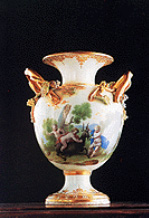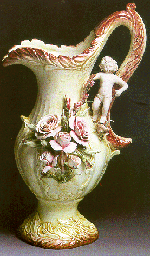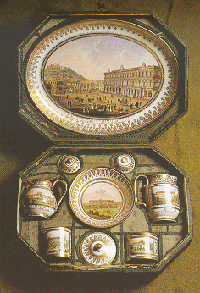Capodimonte Porcelains
The Capodimonte Porcelain Manufacture finds its origin in 1738, the year of the marriage of King Charles to Maria Amalia Valpurga, daughter of Frederick Augustus Elector of Saxony and grand-daughter of Augustus the Strong, the founder of the famous Messein Porcelain Manufacture.
The King intended by these porcelains to provide a retaining memory of the royal wedding and also rise the kingdom at the level of some of the most prestigious European Courts having their own porcelain manufacture, such as the Saxony, the French and the Hapsburg courts. In Italy, however, there were already the Vezzi Manufacture in Venice (1720), the Ginori manufacture at Doccia (1737) and the Rossetti Manufacture in Turin (1737).

The first employees of the factory were Livio Vittorio Schepers, Giovanni Caselli, Livio Gaetano’s son, tasked with the preparation of the porcelain dough; the Florentine sculptor Giuseppe Gricci, who had to mould it, the painter Giuseppe Della Torre, the carver Ambrogio Di Giorgio and a few other workers and apprentices.
The success of Capodimonte porcelains is certainly due to a fortunate harmonisation of the tender high feldspar and high quality dough heightening the beautiful miniatures made with the tip of the brush by Giovanni Caselli. The tender dough allows the coating to “absorb” the decoration and therefore the miniatures seem as made “under the glass”.
The dough is mainly made of kaolin, feldspar and quartz. In the first working phase, each detail of the piece is hand manufactured. After the drying, the piece goes through two phases: the first is a baking done at a temperature of 700-800°C;
 In the second the piece is hand decorated using lead-free colours under a varnish coat, and then the surface is covered with a glass paint made of silica (enamel); after this the porcelain is baked again at 1400-1500°C and its colours become timelessly bright and indelible.
In the second the piece is hand decorated using lead-free colours under a varnish coat, and then the surface is covered with a glass paint made of silica (enamel); after this the porcelain is baked again at 1400-1500°C and its colours become timelessly bright and indelible.
The manufacture of Biscuit, a soft white polished and transparent dough, was particularly famous.
The most suitable materials for the dough came from Calabria, from Fuscaldo and Porghelia, and gave very good results so that the Capodimonte porcelains were considered superior to the French ones.
An extraordinary compact varnish coat made them even more beautiful by giving them a uniform and attenuated light and velvet-like delicate chromatic nuances.
At the beginning the decoration was inspired by the Meissen one, then it mainly followed the Rococo style.
The Capodimonte porcelains took very soon a more elegant and refined mould and more original pieces were produced (animals, birds, single and group statuettes) which became famous all over Europe.
A particular mention must be made to the exquisitely decorated and manufactured snuffboxes, jugs and basins, stick heads in different shapes, polychrome vases, excellent vases, fireside pots, home cups, coffeepots and milkjugs, dinner services with excellent Japanese-like decorations or landscapes, flowers, mythologic scenes and views of Neapolitan villas. All these manufactures were marked by a blue lily.
In 1759, unfortunately, King Charles decided to bring the manufacture and all its workers and artists with him to Madrid, where it stopped its production in 1808. But in Naples the Capodimonte manufacture never stopped its production.
The Royal Manufacture of King Ferdinand
In fact in 1771 Ferdinand IV decided to reopen the manufacture, first in the Royal Palace of Portici and then in the Royal Palace of Naples.
 This was the startup of the Royal Manufacture of King Ferdinand, whose porcelains were marked with a letter “N”, blue in colour and topped by a crown. Its production had three artistic periods: a first period, from 1773 to 1780, under the artistic lead of the painter and sculptor Francesco Celebrano; a second period, from 1780 to 1799 (year of the French invasion), the best period, when all Neapolitan arts flourished and the porcelains triumphed; and a last and third period from 1800 to 1806, the year in which Giuseppe Bonaparte came to Naples and the Royal Manufacture definitely stopped its activities.
This was the startup of the Royal Manufacture of King Ferdinand, whose porcelains were marked with a letter “N”, blue in colour and topped by a crown. Its production had three artistic periods: a first period, from 1773 to 1780, under the artistic lead of the painter and sculptor Francesco Celebrano; a second period, from 1780 to 1799 (year of the French invasion), the best period, when all Neapolitan arts flourished and the porcelains triumphed; and a last and third period from 1800 to 1806, the year in which Giuseppe Bonaparte came to Naples and the Royal Manufacture definitely stopped its activities.
With the coming of Dominio Venuti in 1780, the production received a boost due to his artistic supervision that produced particularly impressive works: important dinner services inspired to paintings, bronze pieces refined with porcelain flowers, vases and sculptures, dressing tables with polychrome decorations showing statuettes, cupids, birds, flowers, and useful pieces of furniture such as wall panels, ceilings or floors, columns or lamps.
In the subsequent decades, however, the various artisans kept – and still keep – this tradition alive and continued along the path marked out by the Bourbons.





